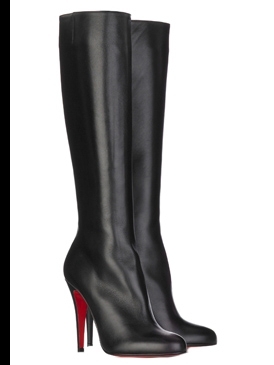-
Posts
1,040 -
Joined
-
Last visited
-
Days Won
6
Content Type
Forums
Profiles
Blogs
Events
Gallery
Posts posted by at9
-
-
The ones I tried and regret not buying...
Knee high 5" heel lace up boots from Little Shoe Box when they were still in business. At the time, many years ago, they were the highest heels I had ever tried. I could stand in them without falling over and took a few steps. I tried them on in LSB's Holloway Road shop and dithered.
Some platform ankle boots from Terry de Havilland when he had a shop in Covent Garden. They were lovely and fitted perfectly but again I dithered.
I would love these Louboutins but unlikely to be available in UK9/EU43 and would be an extortionate price even if they were. In my eyes these are perfection in the bootmaker's craft. Seamless upper and back zip.
-
 8
8
-
-
As I commented on a previous thread,
there's something a bit odd about this website. Despite its.co.uk domain name there's some evidence that the company is actually in China. Look at the CN that appears in the registration details here: http://www.scamner.com/check/just4birminghamjobs.co.uk
If you look at their shiiping and tracking page, it suggests they aren't in the UK. http://www.just4birminghamjobs.co.uk/-ezp-15.html
if you decide to order from them please let us know how you get on.
-
Rather pessimistic article about heels from the BBC website: http://www.bbc.co.uk/news/uk-37517468
-
@ET88 Judging by the smiley in his post (and having met him in person) I'm sure Puffer was joking about 355mm.
-
The UK footwear industry was traditionally centred around the Midlands town of Northampton. The firm that switched from traditional footwear to kinky boots was in that town. There is now very little footwear made there.There is a museum. Here's a bit of trivia about the movie "Kinky Boots":
https://northamptonmuseums.wordpress.com/2016/03/01/shoe-of-the-month-trickers/
-
I saw the original documentary a few years ago on TV. Haven't seen the movie. Plan to see the musical in London sometime. Discount tickets seem to be available from TKTS on most days.
-
So was I:-)
Apart from my last statement which is just a self evident truth.
-
On 16/09/2016 at 5:07 PM, Shyheels said:
.....Fortunately there is not much of any consequence going on in Britain, Europe or indeed the world these days........
There's a minor problem in Syria.
And I've heard there's an election due across The Pond.
Drumpf in heels would not be a pretty sight.
-
The three cardinal rules of journalism. With a liberal dose of cynicism
Make it quick, make it snappy and make it up!
Occam's Razor isn't always correct but it's an excellent starting point.
-
In the US and Canada the men's and women's sizing systems are inherently different. Pumpcat's complaint about Nike could be due to them using men's sizing for women's shoes while Adidas are correctly using the women's sizes.
At least the UK and European systems use the same nominal sizes for both men and women. So a UK8 or EU42 should be the same size whether it's a men's or women's shoe. Even then, there can be a pretty wide variation between different brands of shoe and even different styles within a brand.
-
I first encountered Bugatti Step on a piano roll - I know the guys who did the arrangment and cut the rolls. The piano roll version is also on youtube though a great roll based performance on a rare "Photoplayer" piano has disappeared from Youtube.
Bugatti Step is rarely heard in the UK.but I'll be hearing it live later this week: http://www.cadoganhall.com/event/barry-humphries-weimar-cabaret-2016/ suspect this will be an arrangment for a small group rather than a piano solo.
-
Apparently effortless performance of a very tricky piece. While wearing high heels.
-
 3
3
-
-
Not quite killer heels but certainly exceptional for my fairly dull neighbourhood in Zone 4 of North London. The other day in my local Waitrose I saw a woman wearing 4" classic black pumps. Perhaps a 0.25" platform but no more than that.. Not stiletto but certainly not block heels. She walked completely naturally in them.
-
Actually American rather than English. Often slightly perjorative.
-
The outsourcing company has changed its policy on heels:
http://www.bbc.co.uk/news/uk-england-london-36272893
I wonder if Ms Thorp, the woman who publicised all this, will ever get work from them again.
-
In this particular case the exact legal position looks unclear. Generally in the UK it may be possible for employers to enforce wearing of heels though they must take health and safety into account. I think it would need a case to be brought to an employment tribunal (not applicable in this case) or court to set a legally binding precedent. Or parliament could legislate.
http://www.bbc.co.uk/news/magazine-36265545
http://www.thompsons.law.co.uk/ltext/117-know-your-rights.htm
There have been several news reports in the UK regarding sexual discrimination in school uniform. Here's some:
This private school has introduced some very fair policies:
-
Seems this sort of thing isn't confined to the UK
http://www.jpost.com/Israel-News/El-Al-slammed-for-new-high-heels-rule-for-flight-attendants-406065
I've certainly seen stewardesses on Virgin change from high heels to flats soon after takeoff.
-
http://www.bbc.co.uk/news/uk-england-london-36264229
"A London receptionist was sent home from work after refusing to wear high heels, it has emerged.
Temp worker Nicola Thorp, 27, from Hackney, arrived at finance company PwC to be told she had to wear shoes with a "2in to 4in heel".
When she refused and complained male colleagues were not asked to do the same, she was sent home without pay.
Outsourcing firm Portico said it set the uniform rules for staff supplied to PwC but would now review guidelines."
I wonder what they would have said if a man had turned up for a comparable job wearing heels:)
Not sure about the exact legal position in the UK but it's running very close to sexual discrimination. In any case the outsourcing company has been made to look stupid in public.Not sure why PwC should be outsourcing that kind of job anyway except for temporary cover. If I was running a company I'd want the public/client facing jobs to be directly employed.
-
You are most unlikely to get the police interested in bringing fraud charges. Their usual reaction would be be to say that it's a civil matter which you are free to pursue in the County Court system.
-
I've just looked and you're right. They used to have virtually every style in EU43/UK9, now nothing with heels, only flats. I think some of their EU42/UK8 may fit my feet - I have a pair of EU43/UK9 ankle boots that need an insole.
-
@ALexC94 if you're a UK7 then you've got the whole world of women's footwear available to you. A lot of guys will be jealous.
I'm UK9/EU43 which is a bit limiting but I'm vastly better off than those with big feet.
i think those Demonias go up to UK9. I have a pair of high wedge platform Demonia boots, nominally a women's style, and these go up to UK9.
-
 1
1
-
-
His workshop is on an industrial estate in Enfield though the google map on the website shows a different location, possibly his old workshop. Not too far from me so if I'm over that way I'll take a look.
The registered office is very near me in a road that's full of Victorian terraced houses. Looks like the address is of an accountant who has his office at his house. http://accountants.b99.co.uk/finchley/p-r-s-accoutancy-and-taxation-services/
It's impossible to say whether CK is dishonest or overwhelmed. In either case I wouldn't be prepared to place and order with his company.
-
When you google Fabulously Fetish it comes up as Cos K, wholesalers of shoes. The address is a private house, less than 5 miles from where I live.
Is it true that Cos K was part of The Little Shoe Box, when that was trading years ago in Holloway Road?
-
GITF could be a typo (T is next to Y on the keyboard) or the pleasantly archaic: "Google Is Thy Friend". Or you could just use the rather crude: "JFGI".




Where to buy larger size high heels
in For Everybody
Posted
Since Dutch men and women are some of the tallest on the planet (on average) perhaps they also have bigger feet than average. Hence the abundance of women's shoes in larger sizes.